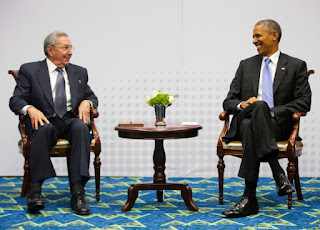Cuban President Raúl Castro (L) and Barack Obama meet in Panama. AP Photo/Pablo Martinez Monsivais
BY MICHAEL WEISSENSTEIN
The Associated Press
HAVANA – The United States and Cuba have struck a deal to allow as many as 110 regular airline flights a day, allowing a surge of U.S. travel to Cuba that could eventually flood the island with hundreds of thousands more U.S. visitors a year, officials said Thursday on the anniversary of detente between the Cold War foes.
The deal reached Wednesday night after three days of talks in Washington opens the way for U.S. airlines to negotiate with Cuba’s government for 20 routes a day to Havana and 10 to each of Cuba’s other nine major airports, the State Department said. While it will likely take months before the first commercial flight to Havana, the reestablishment of regular aviation to Cuba after half a century will almost certainly be the biggest business development since the two countries began normalizing relations last year.
Even a fraction of the newly allowed number of flights would more than double current U.S. air traffic to Cuba but it may take years to reach that number. U.S. travel to Cuba has risen by more than 50 percent this year alongside an even greater surge in travel from other countries, overwhelming the country’s outmoded tourist infrastructure.
Havana’s international airport is barely able to accommodate current demand for flights into the city and virtually every hotel is booked well into next year.
It seems almost certain that Cuban officials will allow new U.S. flights slowly in order to make sure the government can handle the increase in travel.
The United States and Cuba publicly say they’re delighted with the state of diplomatic relations a year after Presidents Barack Obama and Raúl Castro declared the end to more than 50 years of official hostility. The two countries have reopened embassies in Havana and Washington; agreed to a pilot program restarting direct mail service; signed two deals on environmental protection; and launched talks on issues from human rights to compensation for U.S. properties confiscated by Cuba’s revolution.
“We are advancing our shared interests and working together on complex issues that for too long defined — and divided — us,” Obama said in a statement issued Thursday.
“Meanwhile, the United States is in a stronger position to engage the people and governments of our hemisphere,” he added. “Congress can support a better life for the Cuban people by lifting an embargo that is a legacy of a failed policy.”
The U.S. secretaries of state, commerce and agriculture and the Cuban-born deputy secretary of homeland security have all made official visits to start discussions on unsexy but vital technical matters like produce inspecttion and port regulations.
Sports and cultural activity is heating up too. Havana has been swamped by U.S. celebrities. Music promoters are jostling to hold a U.S. pop concert in the capital early next year. Major League Baseball stars including Cuban-born defectors Yasiel Puig and Jose Abreu were warmly welcomed by the Cuban government this week on a goodwill trip meant to pave the way for spring training games in Cuba in 2016.
But until this week there has been virtually no progress on business ties, a major part of Obama’s new policy on Cuba. When he unveiled that policy on Dec. 17, 2014, Obama delivered a glowing vision of U.S. visitors using debit and credit cards made possible by new banking links. U.S. companies would export a wide range of goods including telecommunications equipment.
Almost none of that has happened.
Sprint and Verizon have signed roaming deals with Cuba’s state telecommunications company that benefit a small class of U.S. travelers.
